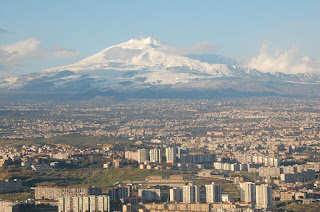Mount Etna, a towering giant on the eastern coast of Sicily, Italy, is more than just a breathtaking natural wonder. It's a living, breathing testament to the Earth's dynamic processes. As Europe's most active volcano, Etna has captivated scientists and the public alike for centuries.
 |
| Source: wikimedia This file is licensed under the Creative Commons Mt Etna, with Catania in the foreground |
A Volcano in Constant Evolution
Etna isn't a single, monolithic structure. It's a complex system of overlapping volcanic cones, lava flows, and craters, shaped by millions of years of eruptions. This constant evolution is a result of its position at the convergence of the African and Eurasian tectonic plates. As these plates grind against each other, magma, molten rock from beneath the Earth's crust, is forced upward, creating the conditions for volcanic activity.
One of the most intriguing aspects of Etna is its eruptive behavior. Unlike many volcanoes that have catastrophic, explosive eruptions, Etna is known for its more frequent, but generally less violent, effusive eruptions. This means that lava tends to flow rather than explode, although this can vary depending on the type of magma involved.
The Science Behind the Eruptions
The type of eruption is determined by the magma's composition. Magma with a high silica content is more viscous, making it more likely to trap gases and lead to explosive eruptions. On the other hand, magma with lower silica content is more fluid and tends to produce effusive eruptions.
Etna's magma is typically basaltic, which is relatively low in silica, contributing to its effusive nature. However, the volcano can also produce more explosive eruptions, especially when there's a higher proportion of gas trapped within the magma.
Recent Activity and Monitoring
Etna is under constant surveillance by volcanologists due to its potential hazards and scientific importance. Recent years have seen increased activity, with several eruptions producing impressive lava flows and ash plumes. For instance, in 2021, a series of spectacular eruptions captured the world's attention.
Monitoring Etna involves a range of techniques, including seismic monitoring to detect underground movements, gas analysis to measure changes in volcanic emissions, and ground deformation measurements to identify swelling of the volcano. These data help scientists to assess the volcano's behavior and issue warnings when necessary.
A Living Laboratory
Beyond the awe-inspiring spectacle of its eruptions, Etna is a valuable resource for scientific research. The volcano provides a unique opportunity to study a wide range of geological and environmental processes. From understanding magma formation to investigating the impact of volcanic gases on the atmosphere, Etna offers a wealth of knowledge.
Moreover, the unique ecosystem around Etna has adapted to the volcanic environment. Specialized plants and animals have evolved to thrive in the harsh conditions, making the area a hotspot for biodiversity studies.
Mount Etna is a constantly evolving natural wonder. Its scientific importance, coupled with its dramatic beauty, ensures that it will continue to fascinate and challenge researchers for generations to come.
Note: For the most up-to-date information on Etna's recent activity, I recommend consulting recent scientific publications or news articles from reputable sources such as the Italian National Institute of Geophysics and Volcanology (INGV) or the European Union’s Copernicus Emergency Management Service.
References:
- The Wonders of Mount Etna: Slopes, Landscapes, and Adventures
- Mount Etna - Atlas Obscura
- Mount Etna - Britannica
- Etna History
- Why Do Some Volcanic Eruptions Consist Mostly of Lava Flows?
- Basaltic Magmas and Their Eruptions
- Remote Sensing of Volcanic Activity
- Mount Etna: A Volcanologist’s Paradise
- The Fauna of Mount Etna in Summer
- Etna: An Ever-Changing Natural Laboratory




0 Comments